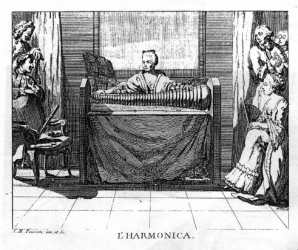| Forecasted
description of the project in April 2000 -
page 1/7 |
04/2000 |
Request for support from
the Académie Desprez for
Des Orages
Proposed project for a
musical composition for glassharmonica and recorded electronics
created with the sound of Drottningholm Slottsteater's wind and
thunder machinery
Rémy-Michel Trotier
April 2000
The
glassharmonica

Glassharmonica
of recent manufacture

Source :
http://www.chez.com/thomasbloch/
A demand for
works for the glassharmonica.
Invented in 1761 by Benjamin
Franklin, the glassharmonica is a musical instrument, which
works on the principle of wet glass being rubbed with fingers.
It is made up of a series of glass bowls encased within each
other that turn around on a horizontal axis; the interpreter
rubs the bowls with his wet fingers, which makes the glass
vibrate
The instrument fell into
disuse in the XIXth century. One superstitious reason
put forward for this was that the sound played on the nerves of
the listeners (perhaps a supernatural influence?) and for this
reason it was banned by the police in Germany at the beginning
of the XIXth century. In reality, however, the
glassharmonica's progressive decline was more likely to have
been caused by the increased size of the concert venues and the
comparative lightness of the sound to carry in such auditoria.
It has therefore long been
considered that the glassharmonica could no longer play a part
as a solo instrument, but it has undergone a renaissance in the
years since 1980. This has largely been brought about through
the rediscovery of the original repertory of works and also
through its atmospheric use in film music. Significantly, the
master glassmaker, Gerhard Finkenbeiner has restarted production
of the glassharmonica and some hundred instruments have been now
been manufactured. Today, many amateurs play this instrument,
rediscovering a many of the 400 pieces composed between 1761 and
1835.
In France, the glassharmonica
has found an exceptional interpreter: Thomas Bloch is one of the
two only professional glassharmonicists in the world. He
regularly presents this ancient instrument, whose revival he
sustains, through his concerts. He also participates in the
festival that takes place in Philadelphia, native city of the
instrument’s inventor, Benjamin Franklin. This festival
gathers, every three years, attracting music lovers and amateur
interpreters fascinated by the glassharmonica. For each of these
festivals, Thomas Bloch presents contemporary works commissioned
for the occasion
Playing two other equally rare
instruments of the XXth century, the Cristal Baschet
and the Ondes Martenot, Thomas Bloch is one of these virtuosi
that do not undertake the practice of their art without strong
links to the contemporary creation. In this spirit, Thomas Bloch
has made a plea for contemporary works for glassharmonica or
glassharmonica and electronics; selected pieces are presented
during of the festival in Philadelphia.
This project of a new musical
piece for glassharmonica and electronics, Des Orages,
aims to answer his demand for works.
Putting
together the harmonica and the sounds of Drottningholm
|
